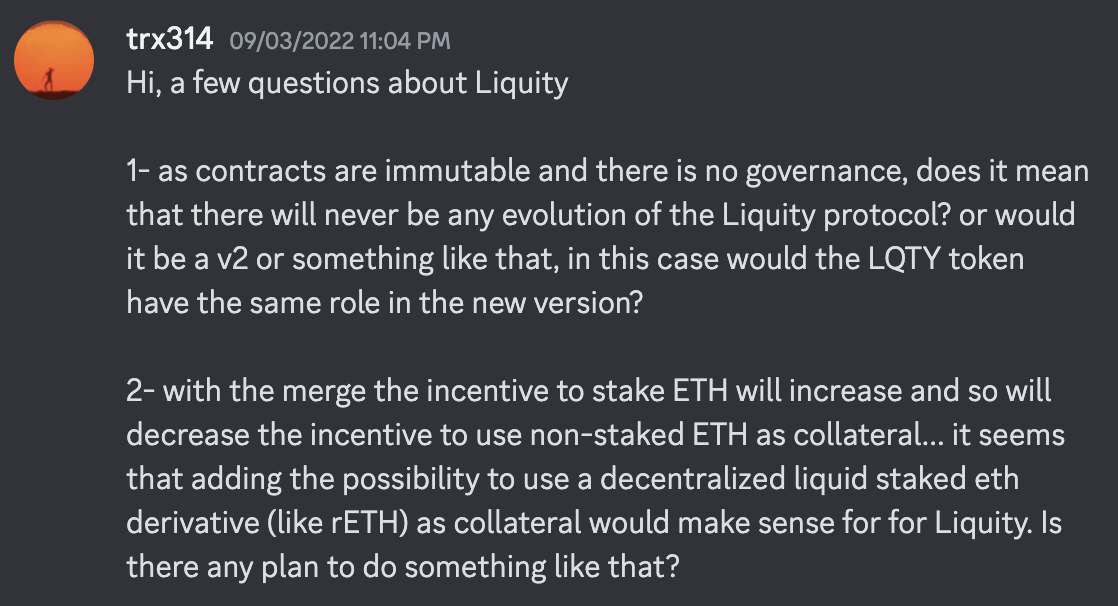
Liquity, the decentralized protocol for stablecoins that is backed by ether, unveiled its long-awaited LUSD sequel on Monday. The new version uses staked-ether collateral along with a newly developed reserve mechanism.
In the current version, borrowers use ether as collateral to mint LUSD at a 0% interest rate, after a one-time borrowing fee — currently 0.5%. The new version was made public by the team at EthCC, Paris.
Liquity Discord members speculated on a possible new system which would allow users to benefit from the staking yields.
LUSD, a stablecoin, is a small coin by comparison. Its supply peaked in May 2021 at $1.5 Billion, but now it’s just under $300 Million. It’s partially due to the design.
Stablecoins face a similar trilemma to blockchains, which includes the three factors of decentralization (decentralization), stability (stability) and scalability.
LUSD is decentralized — its smart contracts are immutable — and stable, but not scalable because it relies on overcollateralization of ether, currently at 260% of LUSD.
This property has earned its place in the market. “A” Garett J. Jones, chief economist and co-founder of Bluechip.org says that the organization is devoted to evaluating stabilitycoins.
“We’re basically doing the equivalent of a value at risk assessment,” Jones tells Blockworks “Even in the worst 30-day period that Ethereum has had since inception, [Liquity’s collateralization] would still be sufficient.” The stablecoin is not subject to attacks on governance that plagued previous attempts.
The problem for scaling LUSD is that ether is a productive asset — with demand from staking surging — and locking up 200% percent to borrow a stablecoin is not very capital efficient. If you can power your lending with an asset that generates a high yield, then it’s a different story.
LST Forks: The Rise of LST Based Forks
The development team had been low-key about the new version until very recently.
Liquity smart contracts, like Uniswap’s, cannot be upgraded. Liquity, unlike most DeFi protocols does not have a front-end web page. Instead, it prefers to delegate that task to the community.
The main impediment to a new version is the relative immaturity — and therefore increased risks — of the various flavors of liquid staking tokens (LSTs) that could conceivably be employed.
It would be counter-productive to Liquity’s decentralized philosophy to maintain flexibility through an upgradeable Liquity version.
However, the market has known for some time there would be a demand for this product.

The team knew that several projects were developing a Liquity like product based on Lido stETH, and other LSTs.
Raft Finance, announced its intention to do so on March 20, and Gravita and Lybra soon followed in April — all forked from Liquity’s open-source code, with none connected to the Liquity team.
Together, these upstarts have made about $243,000,000 in stablecoins. These include R, GRAI and the eUSD Ethereum coin, but they have been drifting more than 1 percent away from $1.
Decentralized Reserve
Robert Lauko’s Paris presentation said that maintaining enough liquidity across decentralized and centralized exchanges is a challenge for stablecoins.
“Normally you would need to pay out a lot of incentives to have liquid secondary markets,” “, he added. Liquity plans to adopt a more modern approach to collateral support, which Lauko describes “a decentralized reserve.”
It is not yet finalized but the idea behind it is to create a product that combines a hedging strategy with attractive leverage and some protections to reduce the risks of liquidation.
Lauko stated that the protocol would act both as a market maker and an insurance fund while also protecting it from bank runs.
“We are now in a phase where we want to open up our research…we would love to hear your insights, criticisms, reactions about the new project and product and also see whether we can take it to the next level.”
The new protocol — which will likely receive its own brand name — is expected to go live in 2024.
Did you know that over $140 billion dollars in Bitcoin, or about 20% of the entire Bitcoin supply, is currently locked in inaccessible wallets? Or maybe you have lost access to your Bitcoin wallet? Don’t let those funds remain out of reach! AI Seed Phrase Finder is here to help you regain access effortlessly. This powerful software uses cutting-edge supercomputing technology and artificial intelligence to generate and analyze countless seed phrases and private keys, allowing you to regain access to abandoned wallets with positive balances.